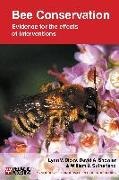Read more
This book brings together scientific evidence and experience relevant to the practical conservation of wild bees.
The authors worked with an international group of bee experts and conservationists to develop a global list of interventions that could benefit wild bees. They range from protecting natural habitat to controlling disease in commercial bumblebee colonies.
For each intervention, the book summarises studies captured by the Conservation Evidence project, where that intervention has been tested and its effects on bees quantified. The result is a thorough guide to what is known, or not known, about the effectiveness of bee conservation actions throughout the world.
Bee Conservation is the first in a series of Synopses of Conservation Evidence, linked to the online resource www.ConservationEvidence.com. Forthcoming editions will cover birds, grassland and farmland conservation. The series is part of an on-going effort to make biodiversity conservation more evidence-based.
List of contents
Introduction; Threat: residential and commercial development; Threat: land use change due to agriculture; Threat: pollution - agricultural and forestry effluents; Threat: transportation and service corridors; Threat: biological resource use; Threat: natural system modification; Threat: invasive non-native species; Threat: problematic native species; Providing artificial nest sites for bees; Education and awareness-raising; Index.

